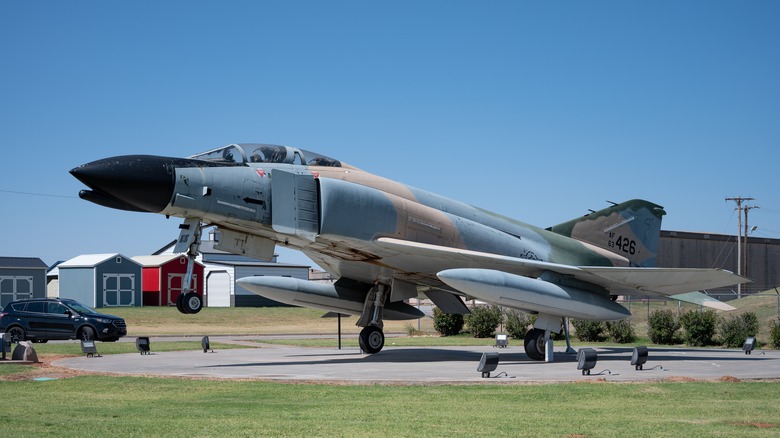Here's What Made The F-4 Phantom II Such An Excellent Fighter Jet
The F-4 Phantom II began flying fleet defense for the U.S. Navy in 1958 but wasn't used by the Air Force until 1963 (as the F-4C). The two-seat, twin-engine tactical jet fighter bomber was built by the McDonnell Aircraft Corporation (later the McDonnell-Douglas Corporation). It could fly in any weather scenario and perform a variety of roles, including air superiority, interdiction, and close-air support.
It was the first fighter aircraft to fly simultaneously with the Navy, Air Force, and Marine Corps, and the only one to be flown at the same time by the flight demonstration teams from both the Air Force (Thunderbirds) and Navy (Blue Angels). By the time it retired in 1996, it had earned a reputation as one of the best fighter jets developed during the Cold War because it was produced in such large quantities, had an incredible service length (38 years), and always performed admirably.
In 1965, the F-4 was used aggressively in the Vietnam War, flying air-to-air missions and attacking targets on the ground. Initially, it was only armed with air-to-air missiles. However, several (unsuccessful) early dogfights with Soviet-built MiG fighters showed the need for additional close-range armaments, so it was retrofitted with 20-millimeter cannons. The Phantom went on to rack up over 100 MiG kills during the war.
When fully loaded it could carry 16,000 pounds of ordnance on nine external hardpoints in any number of configurations that included nuclear or conventional bombs, rockets, missiles, or 20mm cannon pods. By comparison, it carried more than twice that of a World War II B-17 bomber.
This Phantom scared all of its enemies
The fighter was powered by two General Electric J-79-GE-15s, each creating 17,000 pounds of thrust. It had a maximum speed of 1,400 mph, with a cruising speed of 590 mph. Its range (1,750 miles) and flight ceiling (59,600 ft.) also gave it a considerable advantage. Various iterations of the F-4 (of which there were many) reached speeds of Mach 2.2 (at one time it was one of the fastest fighters in the world), carried 18,000 pounds, had ceilings above 62,000 feet, and went much further (the F-4B had a range of 2,300 miles).
Nearly 5,200 were built by the time production ended in 1979 — 2,600+ for the USAF, 1,200+ for the U.S. Navy and Marine Corps, while some 1,400 of the multi-purpose Phantoms served with as many as 12 other friendly nations.
The Navy's last F-4 landed aboard the USS America in October 1986. During Operation Desert Storm, the Air Force launched F-4G Wild Weasels (a rebuilt version of the F-4E) to track enemy radar and suppress enemy air defenses like SAM batteries. The effectiveness helped the U.S. military control the skies above Iraq and Kuwait within 24 hours.
As of 2020, the F-4 was still in service with Iran, Japan, South Korea, Greece, and Turkey. Germany's Air Force still uses Phantoms at Holloman AFB as training platforms for its fighter pilots. Designated as the QF-4 Aerial Target, it still serves as — you guessed it — a supersonic reusable unmanned aerial target for live air-to-air and surface-to-air missile tests. According to the Air Force, there are 84 active QF-4s currently in operation at Tyndall Air Force Base (Florida) and Holloman AFB (New Mexico).
